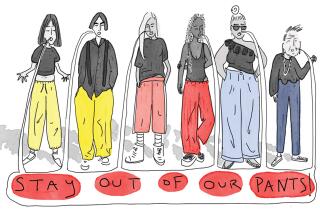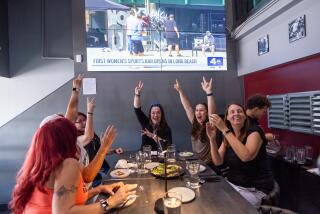Engineered to beat the bounce
FROM humble beginnings -- the first modern sports bra was fashioned from two jockstraps sewn together -- the sports brassiere has emerged as a high-tech apparel powerhouse.
A triumph of engineering over gravity, these slight pieces of fabric are now researched and tweaked to the minutest detail. Some are even tested in biomechanical labs with cameras rolling, reflective tape recording every bounce of the breast, every twist of the nipple.
Just one garment can include eight types of fabrics, with varying amounts of support, sweat-wicking properties and ventilation levels. As a category, they’re made with ever-more-smooth microfibers to reduce friction. Even the straps are specially engineered, some with gel inside for added cushioning.
These advances have been fueled by the growing expectations -- and changing needs -- of women and by the indefatigable efforts of researchers who have made bounce analysis and nipple-tracking a fine art.
One of those scientists, LaJean Lawson, has been conducting sports bra research at Oregon State University’s biomechanics lab for nearly 20 years. Today she is an adjunct professor in exercise and sports science and works with Champion Athleticwear to test and improve sports bra designs.
*
Tracking the smallest detail
To test a bra, Lawson relies on a shifting group of volunteers with varying breast sizes. The women jog on a treadmill at a 6-mph pace, while six cameras set up around them feed data into a computer. Lawson is able to track the motion of the breast in the bra to the smallest detail.
At the end of each trial, Lawson will have simulated figures of the subject’s entire body in motion and of the breasts, moving up and down in space. She can track in slow motion every twist and turn of the breasts, which tend to move in a figure-eight pattern that reflects the arm swing and shoulder rotation during running.
“We can tell you how fast the nipple is going as it changes direction,” she says. “We can calculate velocity and acceleration.” In fact, she says, some of the data are kind of scary.
“Think of when you play crack the whip,” she says. “The skin and much of the underlying tissue in the breast is somewhat elastic, so when you have a breast traveling downward at a pretty good rate of speed, and then you change direction as your body hits the ground and begins to rise up again, you can get some pretty drastic acceleration as the breast speeds up to try to catch up with the rest of the body. The point of the sports bra is just to slow all that down.”
The average 36C breast is estimated to weigh about 10 ounces. Researchers calculate that a breast of this size, with minimal support, running at about 5.6 mph, will bounce as much as 4.7 inches up and down, relative to trunk movement. A good sports bra can decrease this by about one half or more.
Today, Lawson says, breasts are moving somewhat differently in the bras that she’s used as controls over the years. This is due, she suspects, to a higher ratio of fat-to-glandular tissue in the breast. As women have become larger, breasts have followed suit. In the last 10 years, breasts have increased from an average bra size of 34B to 36C or 38C.
The new bras, of course, are following the demand, with better engineering for the bigger breast.
To fully understand the breast, one must start with the fine strands of connective tissue, called Cooper’s ligaments, that separate its lobules. Researchers believe that these ligaments, along with collagen and skin tissue, give the breast its gravity-defying structure. Over time, however, as these tissues become less elastic, breasts lose their perky resilience. A sports bra, in theory, should slow the advent of sagging.
Not everyone is convinced, however. Dr. Jaco Festekjian, an assistant clinical professor of plastic and reconstructive surgery at UCLA, has performed more than 1,000 surgeries on breasts, including reconstructions, augmentations and reductions. Genetics and other factors such as pregnancies, he says, are most likely the biggest determinants of sag.
“The bra can’t control the inherent elasticity of the ligaments,” he says. “The ligaments that hold the breast up loosen over time, with or without a bra, and once they succumb to gravity, they don’t want to bounce back.”
Whether bounce causes sag may be debatable, but comfort isn’t.
Artwork and relics dating back to Greek and Roman antiquity suggest that active women through the ages have grappled with the problem of bouncing breasts, says Kevin Jones, a costume historian at the Fashion Institute of Design and Merchandising Museum in Los Angeles.
“We know from mosaics in AD 340, for example, that women in Sicily exercised in gymnasiums, with barbells, in what looks like sports bras,” he says. “Women at that time did participate in athletics, which ended with the Medieval era, when women’s roles in society became more regulated and restricted.”
The first sports bra in modern history was born in 1977, when Lisa Lindahl of Vermont got fed up with breast pain while running. Inspired by her husband’s jockstrap, she teamed with Polly Smith, a costume designer, and Hinda Schreiber Miller, now a Vermont state senator, to fashion a sports bra from two athletic supporters, cut apart and sewn back together.
The three launched a modified version of the contraption, first as the Jockbra, then quickly renamed it the Jogbra. Initially, sports retailers were skeptical. Women weren’t.
“We rode the growing wave of women participating in college sports,” recalls Miller, linking the emergence of sports bras with the passage in 1972 of Title IX. That landmark legislation prohibited gender discrimination in schools receiving federal assistance, with much of the impact felt in athletics.
The sports bra, in short, helped open a door for all women to exercise comfortably and without feeling foolish. “Over the years the sports bra has changed how we look at our bodies,” says Miller, “and it acknowledges that women of all sizes are entitled to exercise and be fit. Breasts shouldn’t be a factor.”
Today, sports bras are an essential piece of equipment. Between 2000 and 2002, the most recent figures available from Mintel, a market research group, sales of sports bras grew from $300 million to $400 million, a whopping 33% increase in sales.
*
Modern designs
Traditionally, sports bras have fallen into two design types: “compression” or “encapsulation.”
Many new bras are hybrids, stealing a little from each system, using compression to restrict movement and encapsulation to lift and support.
But those choices are just the beginning. High-performance offerings, some already on the market and some coming this summer, include: Moving Comfort’s “nippleproof” bras featuring nipple camouflage and protection; Hind’s new high-tech molded bra; and Under Armour’s Duplicity bra with ultra-smooth mesh for dryness. Even Victoria Secret is getting in on the action, with the “Sexy Sport” line.
Among the bestselling designs are those engineered to support larger cup sizes. Champion says some of its biggest growth is in full-support styles, which go as high as size 44 DD. Moving Comfort, which offers a sports bra for mastectomy patients, is developing a sports bra for active women 34 DD through 46 F.
Researchers say that large-breasted women benefit the most from a good-fitting sports bra and that, for them especially, the wrong bra can be disastrous. “Theoretically, a loose, stretchy bra with a large breast in it can actually propel things a little faster,” says Lawson, “if extreme stretching and recovering of the fabric is occurring. Even a kid knows that if you stretch a rubber band and then let it go, it really flies.”
*
(BEGIN TEXT OF INFOBOX)
Comfort, fit and, of course, support
Choosing the right sports bra -- and getting the proper fit -- requires patience, an eye for detail and a willingness to jump around in the fitting room.
* First things first. Decide if you want a compression or encapsulation style.
Compression bras, like the first Jogbra, usually pull over the head and mash the breasts down, to restrict movement. They comfortably minimize motion in high-impact activities for small- to medium-breasted women.
Encapsulation styles, which separate and support the breasts individually, are usually more comfortable than the compression style for large-breasted women.
* To keep cool and dry, look for wicking microfibers, such as Coolmax. Mesh panels on the front or back will keep you even cooler.
* Look for wide shoulder straps. Wide straps are less likely to dig in. Nonstretch fabrics in the straps will reduce bounce. Ideally they should be inset. “Inset shoulder straps can make a big difference on where you distribute the pressure from holding up the breast on your shoulders and back,” says Jen Elise McKey, a bra selector for Title Nine, a national women’s athletic apparel store.
* Pay extra attention to the fit of the chest strap. It provides the foundation of the fit and should fit snugly around the rib cage.
* Use your regular size as a guideline, but try the bigger and smaller sizes. If you’d rather not worry about bouncing, go tighter.
* Before buying the bra, put it on, jump up and down, bend over. Do as much as you can in the dressing room that will replicate whatever activity you’re planning to wear it for.
* And finally, after purchasing the bra, plan to replace it every six months or so.






